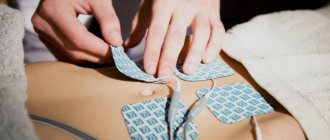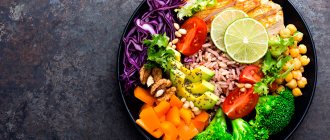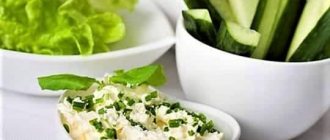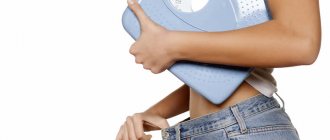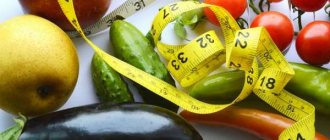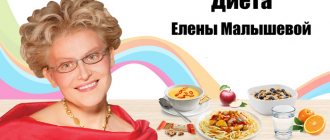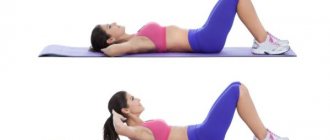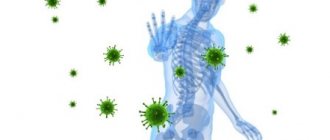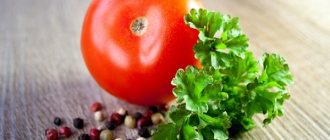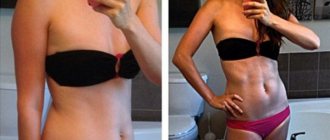Basic rules of diet after cholecystectomy
The goals of therapeutic nutrition after removal of the gallbladder are:
- creating maximum chemical sparing of the liver;
- improvement of bile separation;
- ensuring normal functioning of the liver, bile ducts and the entire gastrointestinal tract.
According to the order of the Ministry of Health of the Russian Federation No. 330, dietary nutrition after cholecystectomy in medical institutions corresponds to the main version of the standard diet (STD). According to Pevzner’s classification, the diet after removal of the gallbladder is treatment table No. 5.
Despite some restrictions in treatment table No. 5, the diet must be physiologically balanced, that is, contain the required amount of vitamins and minerals.
Daily nutrient content:
- proteins – 85-90g, of which 45-50g are animal proteins;
- fats – 70-80g, of which up to 25-30% are fats of vegetable origin;
- carbohydrates – 300-330g, with simple sugars – no more than 30-40g.
The daily calorie content of the treatment table after removal of the gallbladder is 2170-2400 kilocalories.
Basic principles of nutrition
- diet; Meals should be fractional: up to 4-6 times a day, in small portions. Although there is no gallbladder, the bile ducts are preserved, and, therefore, they must be emptied on time so that the bile does not stagnate in them. In addition, small portions of food do not burden the liver and other digestive organs, which avoids inflammation. It is especially important to eat at the same time: this normalizes the functioning of both the liver and bile ducts. Small portions of food prevent the development of obesity, which is of great importance.
- food processing; Food can be steamed, baked or boiled. Cooking food in the microwave should be avoided; multicookers and double boilers are not prohibited. Stewing foods is occasionally allowed. In the first 45 days after the operation, when cutting, the products are crushed and wiped. This type of culinary food processing provides maximum mechanical sparing of the liver and stomach, and also has a beneficial effect on the entire digestive tract.
- food temperature; Dishes are served only warm (15-60 degrees Celsius). Excessively hot and cold foods cause spasms of the bile ducts and irritate the stomach and duodenum.
- salt and liquid; The consumption of sodium chloride corresponds to the physiological norm (8-10 grams per day). Avoid salty foods that irritate the gastrointestinal tract and cause stagnation of fluid, and therefore bile, in the body. Liquids should be consumed up to 2 liters per day. 30 minutes before meals, it is recommended to drink 1 glass of alkaline mineral water without gas, which stimulates the flow of bile.
- alcohol; You will have to stop drinking alcohol (with rare exceptions). Ethyl alcohol causes spasms of smooth muscles and increases the tone of the biliary tract. In addition, in the absence of a gallbladder, the liver alone breaks down alcohol, and the load on it increases. Systematic consumption of alcoholic beverages is dangerous not only by the return of previous problems with the gallbladder, but also by the development of cirrhosis of the liver.
- We eat deliciously. Each meal should be beautifully arranged: at a table covered with a tablecloth, with flowers, in a calm atmosphere. It is necessary to eat slowly, chewing each piece thoroughly. This will allow you to be satisfied with very moderate portions, which will have a beneficial effect on weight and ensure minimal stress on the gastrointestinal tract.
A person who has undergone surgery to remove the gallbladder must follow a diet for the rest of his life, since he does not have a reservoir where bile previously accumulated. After such an operation, you need to strive to ensure that bile does not stagnate in the bile ducts. This can be achieved only in one way - eat more often. Stagnation of bile in the biliary tract should under no circumstances be allowed, as the process of stone formation may begin. Therefore, you need to eat food at least five times a day, in small portions, preferably at the same hours. Food must be chewed thoroughly. All food should be eaten warm.
It is important to remember that fried foods are contraindicated, since the frying process preserves substances that affect the secretion of digestive juices and irritate the mucous membrane of the gastrointestinal tract. Such activation of the digestive process is detrimental in the absence of a gallbladder. Therefore, food needs to be steamed, stewed or boiled.
What foods can you eat after gallbladder removal (cholecystectomy)?
1. It is necessary to introduce vegetable and dairy fats into the diet, as they help the rapid discharge of bile. For breakfast and dinner, fermented milk products are optimal, as well as cottage cheese dishes: puddings, casseroles, cottage cheese pancakes, cheesecakes. But they need to be seasoned with low-fat sour cream. You can diversify your morning and evening menu with omelettes and soft-boiled eggs.
2. For lunch, first courses should be cooked only in weak meat or vegetable broths, adding various cereals. It is still better to give preference to vegetable broths. Main courses should be prepared from lean beef or chicken. It is also recommended to eat low-fat fish 2 times a week, especially sea fish, which promotes the absorption of fats.
3. Since fats take an active part in all metabolic processes, it is impossible to do without them completely. Therefore, it is necessary to consume vegetable fats and butter. Flaxseed oil is very useful.
4. Bran is great.
5. It is better to eat yesterday's bread, dried.
6. Very good seasonings are herbs, bay leaves, and turmeric, which have medicinal properties.
7. When the gallbladder has been removed, the diet should include a variety of porridges (buckwheat, pearl barley, rice, oatmeal), vegetables (especially carrots and pumpkin), fruits and berries, with the exception of sour ones. Watermelons and melons, which have a diuretic effect, are also useful to consume, as they remove harmful substances and toxins from the body. For dessert you can eat honey, marshmallows, jam, marmalade, but in small doses. Sweets can be replaced with dried fruits: dried apricots, prunes.
What foods should not be consumed if the gallbladder has been removed?
1. First of all, these are those products that irritate the mucous membrane of the gastrointestinal tract. These include a variety of spices, onions, garlic, radishes, radishes, and mushrooms. Meat, fish and mushroom broths, spicy, sour, marinades and pickles are also contraindicated.
2. The amount of enzymes in bile that facilitate the digestion of fats decreases after removal of the gallbladder. Therefore, it is necessary to completely exclude from consumption lard, beef and lamb fat, fatty meat, as well as all kinds of sausages and frankfurters, because the substances contained in them disrupt the circulation of bile.
3. Sweets, cakes, pastries, sparkling water.
4. Those foods that contain a large amount of coarse fiber: beans, peas, wholemeal bread, etc.
5. You should not eat sauerkraut, as it causes fermentation.
6. Cold foods, as a spasm of the bile ducts may occur (ice cream, jellied meat, etc.).
7. Alcohol is strictly prohibited
So, by excluding the listed foods from your diet, you will avoid unwanted consequences.
Prohibited Products
First of all, it is necessary to exclude foods with high cholesterol content from the diet after removal of the gallbladder. It is this that causes thickening and stagnation of bile and promotes stone formation.
Secondly, since the bile after removal of the bladder does not contain most of the enzymes that break down fats, the consumption of animal (refractory) fats should be limited.
You should also avoid products that increase bile formation and secretion of gastric and duodenal juices (extractives, spicy foods, marinades, etc.). It is contraindicated to eat foods that linger in the intestines for a long time, causing rotting and fermentation, stimulating gas formation.
The consumption of simple carbohydrates must also be limited: they are easily broken down, increasing the level of “bad” cholesterol, and are stored in the form of fatty layers.
The list of prohibited products includes:
- bread made from premium flour, all pastries and fried dough products (pancakes, pancakes, pies, as well as cakes and pastries);
- cooking oil, margarine, any lard:
- rich broths and soups made from them (meat, fish, poultry);
- fatty meats and poultry (goose, duck, pork, lamb), stringy meat;
- fatty fish (mackerel, sturgeon, catfish, burbot, salmon);
- canned meat and fish;
- all sausages;
- liver (kidneys, liver, brains);
- fish caviar;
- sour and bitter vegetables (radishes, radishes, green onions, spinach, sorrel, daikon);
- fried eggs, egg yolks;
- marinades and pickles;
- smoked meats;
- spices: pepper, mustard, horseradish, vinegar, coriander and others;
- sour berries and fruits;
- ice cream, chocolate, cream products;
- strong tea, coffee, cocoa, sweet carbonated drinks, sparkling mineral waters;
- legumes;
- dishes from public food outlets (pizzas, hamburgers).
Danger: indigestion
Normally, bile is produced in the liver, enters the gallbladder, accumulates there, becoming more concentrated, and when eating food is thrown into the duodenum.
After surgery, bile is sent to the intestines directly from the liver, so its concentration is lower - it is only sufficient to digest small portions of food. If a person eats a lot, heaviness in the stomach and nausea occur. In addition, removal of the gallbladder leads to a decrease in the activity of digestive enzymes. How to avoid?
Take care of your liver . In the first months after surgery, choose boiled and steamed dishes, preferably pureed. Everything fried, fatty, spicy, and salty will have to be temporarily banned, as will alcohol. This will allow the digestive system to adapt to new conditions. After six months, the diet can be expanded to include fresh fruits and vegetables (except onions, garlic, radishes, lemons), fish and meat in pieces. After a year and a half, return to your usual diet. But it is better to abstain from refractory fats (for example, lamb or lard) and overly spicy foods for the rest of your life.
Chew slowly. The gradual intake of food into the stomach allows you to “wake up” the enzymes and gives the liver time to start working.
Take enzymes. After gallbladder removal, people often need medications to replace some of the missing enzymes. Contact a specialist and select the right product.
Authorized Products
Dishes that are recommended to be consumed by a person who has undergone cholecystectomy should not be irritating or unnecessarily stimulate the gastrointestinal tract.
When preparing food, it is necessary to use products that are rich in pectins and lipotropic substances. Lipotropic substances break down cholesterol, prevent its deposition on the walls of blood vessels (atherosclerosis) and accumulation in the bile, which causes its thickening. Pectins, in turn, gently envelop the mucous membranes of the digestive tract, prevent the absorption of harmful substances, stimulate intestinal motor function and have a healing effect.
In addition, the patient's medical diet after removal of the gallbladder should include large quantities of plant fiber. It not only contains vitamins, but also stimulates intestinal motility, preventing flatulence, constipation and retention of food masses in it.
We should not forget about fermented milk products, because they are sources of valuable animal protein and calcium, and contain live bacteria that have a beneficial effect on the intestinal microflora.
The list of permitted products includes:
- yesterday's bread or dried bread, crackers, biscuits, crackers;
- soups with secondary broths, soups with vegetable broth;
- lean meats and poultry (turkey, chicken, veal, rabbit, beef);
- unsalted and low-fat ham;
- porridges, both crumbly and semi-viscous (buckwheat, oatmeal);
- all seafood as a source of iodine, neutralizing cholesterol;
- low-fat fish (pike, trout, salmon) as a source of polyunsaturated fatty acids;
- steamed egg white omelette;
- vegetable oils, butter for dishes;
- cottage cheese, kefir, yogurt, “live” yogurt, unsalted and low-fat cheeses;
- fruits and berries (very sweet and sour in processed form: jellies, mousses, jellies, compotes);
- jam, marmalade, chalk;
- fresh herbs, tomatoes, cucumbers, sweet peppers, pumpkin, beets, zucchini, potatoes, carrots;
- tea with milk or lemon, weak coffee, alkaline mineral waters, juices and fruit drinks;
- lightly salted salmon, jellied fish, vinaigrette, soaked herring, fresh vegetable salads.
It seems it's time to talk about herbal remedies
There are a great many of them and not only pharmaceutical ones, such as choleretic teas, rose hip syrup, corn silk extract, but especially recipes from herbalists and traditional healers.
For indigestion:
Bird cherry berries (3 parts) and blueberries (2 parts) rich in dietary fiber help with relaxation. Fill for 20 minutes 2 tbsp. spoons of a mixture of sorbents with an astringent taste, drink ¼ cup of the infusion on an empty stomach in the morning and between meals. A 30-minute infusion of 2 teaspoons of alder fruit (2 parts) and serpentine rhizome (1 part), poured with a glass of boiling water, has a similar effect. This portion is drunk in three doses.
For persistent constipation:
Before and after the operation, jam from 300 g of dried apricots, prunes, figs minced through a meat grinder with the addition of Alexandria hay leaf (50 g) and honey (200 g) helps. Eat 1 teaspoon of jam at dinner or 1-3 times during the day with tea or water.
Anesthetic and sorbent collection:
In my many years of practice, for all disorders associated with the elimination of the gallbladder, I usually prescribe an optimally composed and very effective collection of the Vladimir herbalist S.I. Mikhalchenko. It includes plants with analgesic and sorbing properties - burdock roots, sage and plantain leaves, blueberry shoots, knotweed herbs, mint, string and St. John's wort, calendula and chamomile flowers. Take equally - 50-100g. Pour 1 dessert spoon (10 g) of the mixture into 0.5 liters of boiling water in a thermos overnight, and then strain the infusion, take 150 ml an hour before meals 2-3 times a day. Store the drug in the refrigerator and warm it up before use by adding hot water. The course is 3-4 months, 10 days on and 2 days off.
For pancreatitis:
In case of a complication in the form of pancreatitis - a faithful companion of cholelithiasis, I prescribe Mikhalchenko's collection, containing herbs with anti-inflammatory and antispasmodic effects (chamomile, calendula, string, St. John's wort, plantain, St. John's wort), sorbent and astringent properties (blueberry, sage). It contains chamomile and calendula inflorescences, string herbs, St. John's wort, knotweed, sage and plantain leaves, blueberry shoots, burdock roots. Pour 1 dessert spoon of the mixture into 0.5 liters of boiling water in a thermos overnight, then drink 150 ml 3 times a day an hour before meals for 10 days. After a two-day break, continue the course for 1 to 3 months. Store the infusion in the refrigerator.
Choleretic collection:
But you need to be careful with choleretic mixtures and herbs. Of interest is the common barberry, which has a choleretic, anti-inflammatory, analgesic, antispasmodic effect and is used for cholelithiasis and urolithiasis, postcholecystectomy syndrome, and chronic pancreatitis. Preparations: Infusion of barberry leaves 10 g per 200 ml of hot water, close the lid and heat in a boiling water bath for 15 minutes, cool for 45 minutes at room temperature, squeeze out the remaining raw materials. The volume of the resulting infusion is adjusted to 200 ml with boiled water. Reception: 1 tablespoon 3-4 times a day 15 minutes before meals for a month, break 2 weeks, possible repeat course (up to 3-4 months) . Berberine bisulfate in tablets of 0.005 g 2-3 times a day before meals for a month. Repeat the course after a 10-day break. There are no contraindications. After the main course, no more than 2 courses.
Dietary recommendations
After surgery, it becomes difficult for the body to eliminate the bile produced by the liver. In order to help him cope with this difficult task, it is necessary from the first days to switch to fractional meals (4 times a day). Amounts of food should be small. This way you can reduce the load on the digestive tract and avoid cramps in the stomach and intestines.
The diet should be structured so that it contains as much low-fat food as possible. Ideally, all products will be boiled, baked or steamed. Fried and smoked foods will have to be excluded immediately. Many raw foods (such as tomatoes) also need to be eliminated. It is better to prepare stewed vegetables with a minimum amount of vegetable oil instead of salad.
The main principles that a person who has undergone gallbladder removal must observe are the following:
- You should eat no more than three hundred grams of food at a time. In the first two weeks, portions should be 200 grams.
- If you feel a bitter taste in your mouth and pain in your stomach, then fractional meals should be increased from four times to six.
- There should be at least three hours between your last meal and bedtime. Otherwise, the stomach and intestines will not be able to digest food.
- To avoid irritation of the gastric mucosa, it is recommended to replace coffee, tea and alcoholic drinks with regular drinking water and herbal infusions. You need to drink a lot of water - at least two liters per day. It neutralizes part of the bile produced. Among herbal teas, give preference to chamomile and linden. They neutralize inflammation of internal organs. You can also brew rose hips, as they stimulate the excretion of bile from the body.
- All food consumed must be warm. Freshly prepared food is prohibited, as hot food will injure the stomach. Food taken out of the refrigerator can lead to spasm of the bile ducts.
- Try not to eat large pieces. Even if you don’t have problems with your teeth, some of the food that gets into your stomach will still be poorly chewed. It is ideal if you grate vegetables and fruits or chop them in a blender. If you cannot completely give up fresh fruits, then at least peel them. It always contains a lot of fiber, which additionally loads the intestines.
Over time, the diet can be gradually changed. So, in the first week after discharge from the hospital, you need to give up fresh berries and vegetables. It is forbidden to eat rye bread, which stimulates bile secretion. The basis of the diet should be pureed baked or stewed vegetables, steamed fish and lean meat. Porridges such as oatmeal or buckwheat are suitable as a side dish. All this must be ground in a blender until pureed. If you want to pamper yourself with something tasty, you can prepare a steam omelet (preferably only from proteins), casserole, or milk soup. Before going to bed, you are allowed to eat low-fat yogurt or drink a glass of kefir with a piece of Adyghe cheese.
From the second week you can switch from a strict diet to a gentle one. You can eat almost everything. The main thing is that the food is steamed, without oil or hot seasonings. For example, for breakfast it would be nice to try steam pudding and a glass of fruit jelly. Lunch can be varied with steamed cutlets or a piece of boiled fish with mashed potatoes. For dinner, prepare milk porridge or stewed vegetables.
A month after the operation, you can already focus on your well-being. If the body reacts normally to regular (not pureed) food, gradually introduce it into the diet. You can also start adding vegetable or butter to your dishes.
Consequences of violation of diet therapy
In the first months, many find it difficult to follow a diet and small meals. But departure from the rules can lead to dire consequences. Thus, overeating is fraught with stomach cramps, disturbances in the functioning of the intestines, esophagus and pancreas. This is due to the fact that after removal of the gallbladder, the body produces slightly less bile. She can handle digesting small amounts of food. If there is a lot of it, then the food becomes a dead weight in the stomach.
Failure to follow a diet and abuse of heavy foods can provoke the development of such serious diseases as cholangitis and duodenitis. If you do not avoid fried and fatty foods, stones may form in the bile ducts. And this is fraught with new surgical intervention.
Removing the gallbladder is not a death sentence. If you have undergone surgery, do not panic and join the ranks of people whose life has ended. Develop a dietary menu for yourself, follow the recommendations of doctors - and your life will continue to be full and joyful.
